Legal Issues in Surveying: Easements, Misrepresentation, Nuisance
VerifiedAdded on 2019/09/20
|6
|2315
|406
Report
AI Summary
This report provides legal advice to a multi-disciplinary surveying practice regarding issues faced by a client developing student accommodation. The advice covers three main issues. The first issue concerns an easement of light claim from a neighboring property, analyzing the rights of the warehouse owner and the implications of the apartment block construction under building and land management law. The second issue addresses a misrepresentation claim against the seller of the land, detailing the fraudulent misrepresentation made by the seller regarding issues with neighboring owners and advising on remedies such as making the contract voidable and claiming damages. The third issue discusses a threatened private nuisance claim, offering advice on the legal aspects of the situation. The report references relevant legal principles and regulations, including the Consumer Contracts Regulations 1999, to provide a comprehensive analysis and actionable recommendations for the surveying practice.
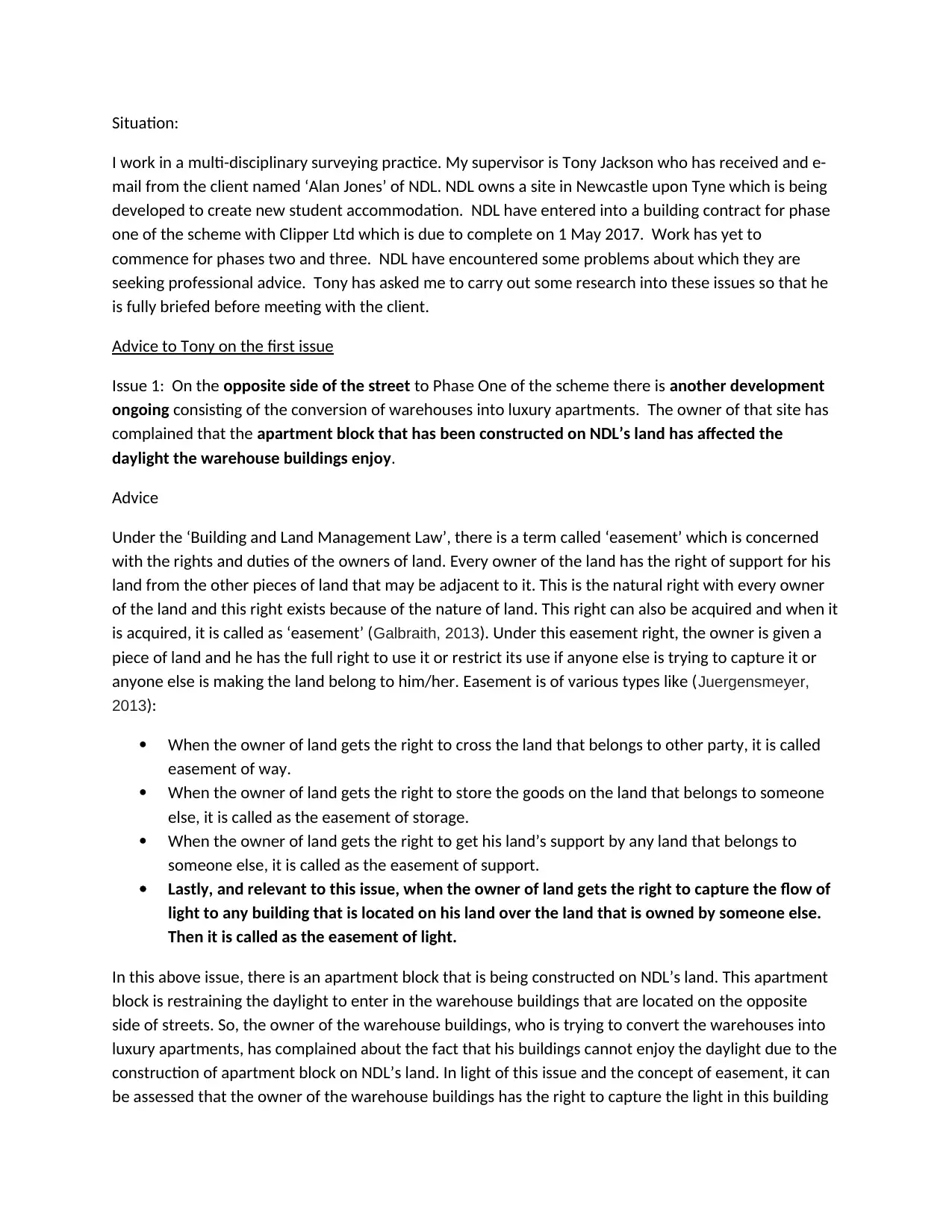
Situation:
I work in a multi-disciplinary surveying practice. My supervisor is Tony Jackson who has received and e-
mail from the client named ‘Alan Jones’ of NDL. NDL owns a site in Newcastle upon Tyne which is being
developed to create new student accommodation. NDL have entered into a building contract for phase
one of the scheme with Clipper Ltd which is due to complete on 1 May 2017. Work has yet to
commence for phases two and three. NDL have encountered some problems about which they are
seeking professional advice. Tony has asked me to carry out some research into these issues so that he
is fully briefed before meeting with the client.
Advice to Tony on the first issue
Issue 1: On the opposite side of the street to Phase One of the scheme there is another development
ongoing consisting of the conversion of warehouses into luxury apartments. The owner of that site has
complained that the apartment block that has been constructed on NDL’s land has affected the
daylight the warehouse buildings enjoy.
Advice
Under the ‘Building and Land Management Law’, there is a term called ‘easement’ which is concerned
with the rights and duties of the owners of land. Every owner of the land has the right of support for his
land from the other pieces of land that may be adjacent to it. This is the natural right with every owner
of the land and this right exists because of the nature of land. This right can also be acquired and when it
is acquired, it is called as ‘easement’ (Galbraith, 2013). Under this easement right, the owner is given a
piece of land and he has the full right to use it or restrict its use if anyone else is trying to capture it or
anyone else is making the land belong to him/her. Easement is of various types like (Juergensmeyer,
2013):
When the owner of land gets the right to cross the land that belongs to other party, it is called
easement of way.
When the owner of land gets the right to store the goods on the land that belongs to someone
else, it is called as the easement of storage.
When the owner of land gets the right to get his land’s support by any land that belongs to
someone else, it is called as the easement of support.
Lastly, and relevant to this issue, when the owner of land gets the right to capture the flow of
light to any building that is located on his land over the land that is owned by someone else.
Then it is called as the easement of light.
In this above issue, there is an apartment block that is being constructed on NDL’s land. This apartment
block is restraining the daylight to enter in the warehouse buildings that are located on the opposite
side of streets. So, the owner of the warehouse buildings, who is trying to convert the warehouses into
luxury apartments, has complained about the fact that his buildings cannot enjoy the daylight due to the
construction of apartment block on NDL’s land. In light of this issue and the concept of easement, it can
be assessed that the owner of the warehouse buildings has the right to capture the light in this building
I work in a multi-disciplinary surveying practice. My supervisor is Tony Jackson who has received and e-
mail from the client named ‘Alan Jones’ of NDL. NDL owns a site in Newcastle upon Tyne which is being
developed to create new student accommodation. NDL have entered into a building contract for phase
one of the scheme with Clipper Ltd which is due to complete on 1 May 2017. Work has yet to
commence for phases two and three. NDL have encountered some problems about which they are
seeking professional advice. Tony has asked me to carry out some research into these issues so that he
is fully briefed before meeting with the client.
Advice to Tony on the first issue
Issue 1: On the opposite side of the street to Phase One of the scheme there is another development
ongoing consisting of the conversion of warehouses into luxury apartments. The owner of that site has
complained that the apartment block that has been constructed on NDL’s land has affected the
daylight the warehouse buildings enjoy.
Advice
Under the ‘Building and Land Management Law’, there is a term called ‘easement’ which is concerned
with the rights and duties of the owners of land. Every owner of the land has the right of support for his
land from the other pieces of land that may be adjacent to it. This is the natural right with every owner
of the land and this right exists because of the nature of land. This right can also be acquired and when it
is acquired, it is called as ‘easement’ (Galbraith, 2013). Under this easement right, the owner is given a
piece of land and he has the full right to use it or restrict its use if anyone else is trying to capture it or
anyone else is making the land belong to him/her. Easement is of various types like (Juergensmeyer,
2013):
When the owner of land gets the right to cross the land that belongs to other party, it is called
easement of way.
When the owner of land gets the right to store the goods on the land that belongs to someone
else, it is called as the easement of storage.
When the owner of land gets the right to get his land’s support by any land that belongs to
someone else, it is called as the easement of support.
Lastly, and relevant to this issue, when the owner of land gets the right to capture the flow of
light to any building that is located on his land over the land that is owned by someone else.
Then it is called as the easement of light.
In this above issue, there is an apartment block that is being constructed on NDL’s land. This apartment
block is restraining the daylight to enter in the warehouse buildings that are located on the opposite
side of streets. So, the owner of the warehouse buildings, who is trying to convert the warehouses into
luxury apartments, has complained about the fact that his buildings cannot enjoy the daylight due to the
construction of apartment block on NDL’s land. In light of this issue and the concept of easement, it can
be assessed that the owner of the warehouse buildings has the right to capture the light in this building
Paraphrase This Document
Need a fresh take? Get an instant paraphrase of this document with our AI Paraphraser
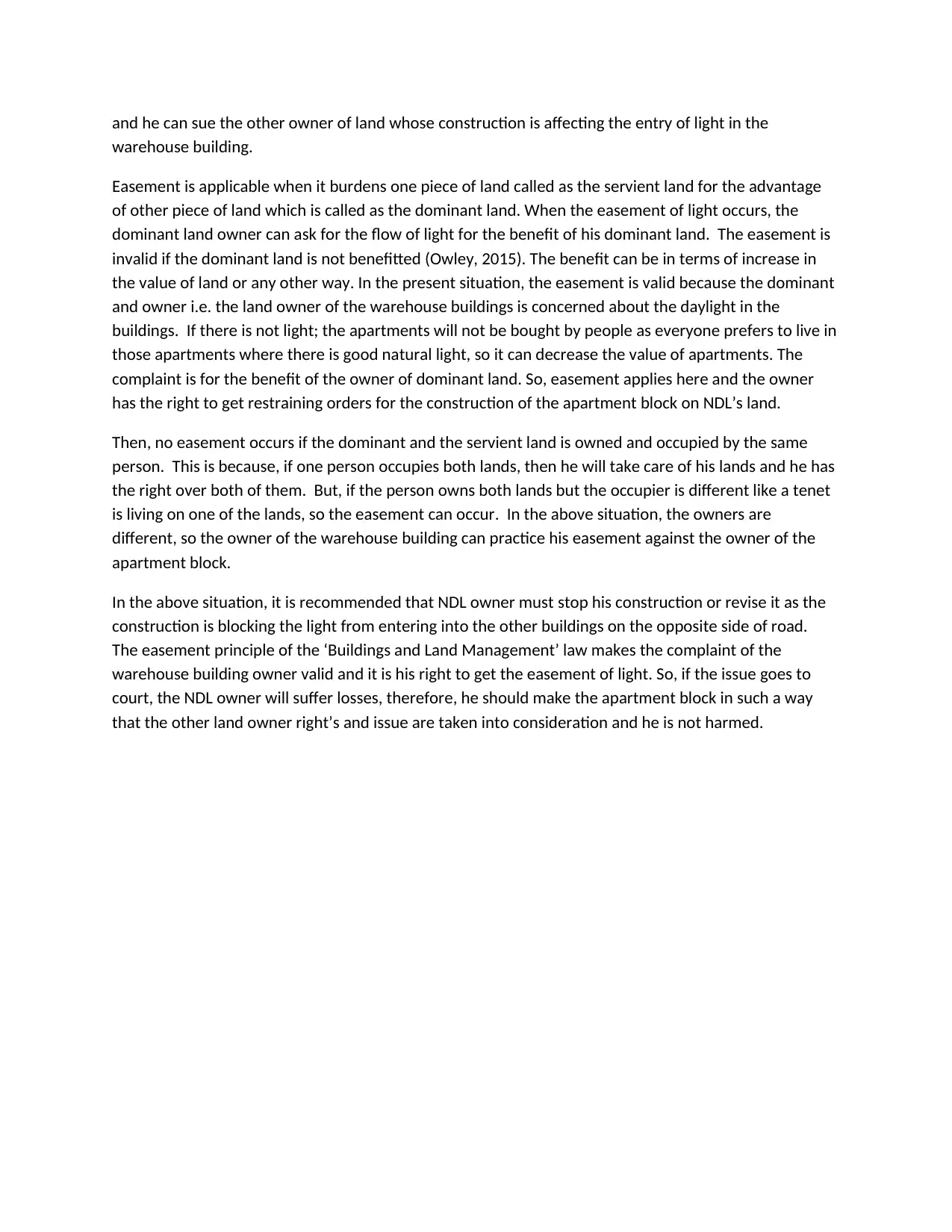
and he can sue the other owner of land whose construction is affecting the entry of light in the
warehouse building.
Easement is applicable when it burdens one piece of land called as the servient land for the advantage
of other piece of land which is called as the dominant land. When the easement of light occurs, the
dominant land owner can ask for the flow of light for the benefit of his dominant land. The easement is
invalid if the dominant land is not benefitted (Owley, 2015). The benefit can be in terms of increase in
the value of land or any other way. In the present situation, the easement is valid because the dominant
and owner i.e. the land owner of the warehouse buildings is concerned about the daylight in the
buildings. If there is not light; the apartments will not be bought by people as everyone prefers to live in
those apartments where there is good natural light, so it can decrease the value of apartments. The
complaint is for the benefit of the owner of dominant land. So, easement applies here and the owner
has the right to get restraining orders for the construction of the apartment block on NDL’s land.
Then, no easement occurs if the dominant and the servient land is owned and occupied by the same
person. This is because, if one person occupies both lands, then he will take care of his lands and he has
the right over both of them. But, if the person owns both lands but the occupier is different like a tenet
is living on one of the lands, so the easement can occur. In the above situation, the owners are
different, so the owner of the warehouse building can practice his easement against the owner of the
apartment block.
In the above situation, it is recommended that NDL owner must stop his construction or revise it as the
construction is blocking the light from entering into the other buildings on the opposite side of road.
The easement principle of the ‘Buildings and Land Management’ law makes the complaint of the
warehouse building owner valid and it is his right to get the easement of light. So, if the issue goes to
court, the NDL owner will suffer losses, therefore, he should make the apartment block in such a way
that the other land owner right’s and issue are taken into consideration and he is not harmed.
warehouse building.
Easement is applicable when it burdens one piece of land called as the servient land for the advantage
of other piece of land which is called as the dominant land. When the easement of light occurs, the
dominant land owner can ask for the flow of light for the benefit of his dominant land. The easement is
invalid if the dominant land is not benefitted (Owley, 2015). The benefit can be in terms of increase in
the value of land or any other way. In the present situation, the easement is valid because the dominant
and owner i.e. the land owner of the warehouse buildings is concerned about the daylight in the
buildings. If there is not light; the apartments will not be bought by people as everyone prefers to live in
those apartments where there is good natural light, so it can decrease the value of apartments. The
complaint is for the benefit of the owner of dominant land. So, easement applies here and the owner
has the right to get restraining orders for the construction of the apartment block on NDL’s land.
Then, no easement occurs if the dominant and the servient land is owned and occupied by the same
person. This is because, if one person occupies both lands, then he will take care of his lands and he has
the right over both of them. But, if the person owns both lands but the occupier is different like a tenet
is living on one of the lands, so the easement can occur. In the above situation, the owners are
different, so the owner of the warehouse building can practice his easement against the owner of the
apartment block.
In the above situation, it is recommended that NDL owner must stop his construction or revise it as the
construction is blocking the light from entering into the other buildings on the opposite side of road.
The easement principle of the ‘Buildings and Land Management’ law makes the complaint of the
warehouse building owner valid and it is his right to get the easement of light. So, if the issue goes to
court, the NDL owner will suffer losses, therefore, he should make the apartment block in such a way
that the other land owner right’s and issue are taken into consideration and he is not harmed.
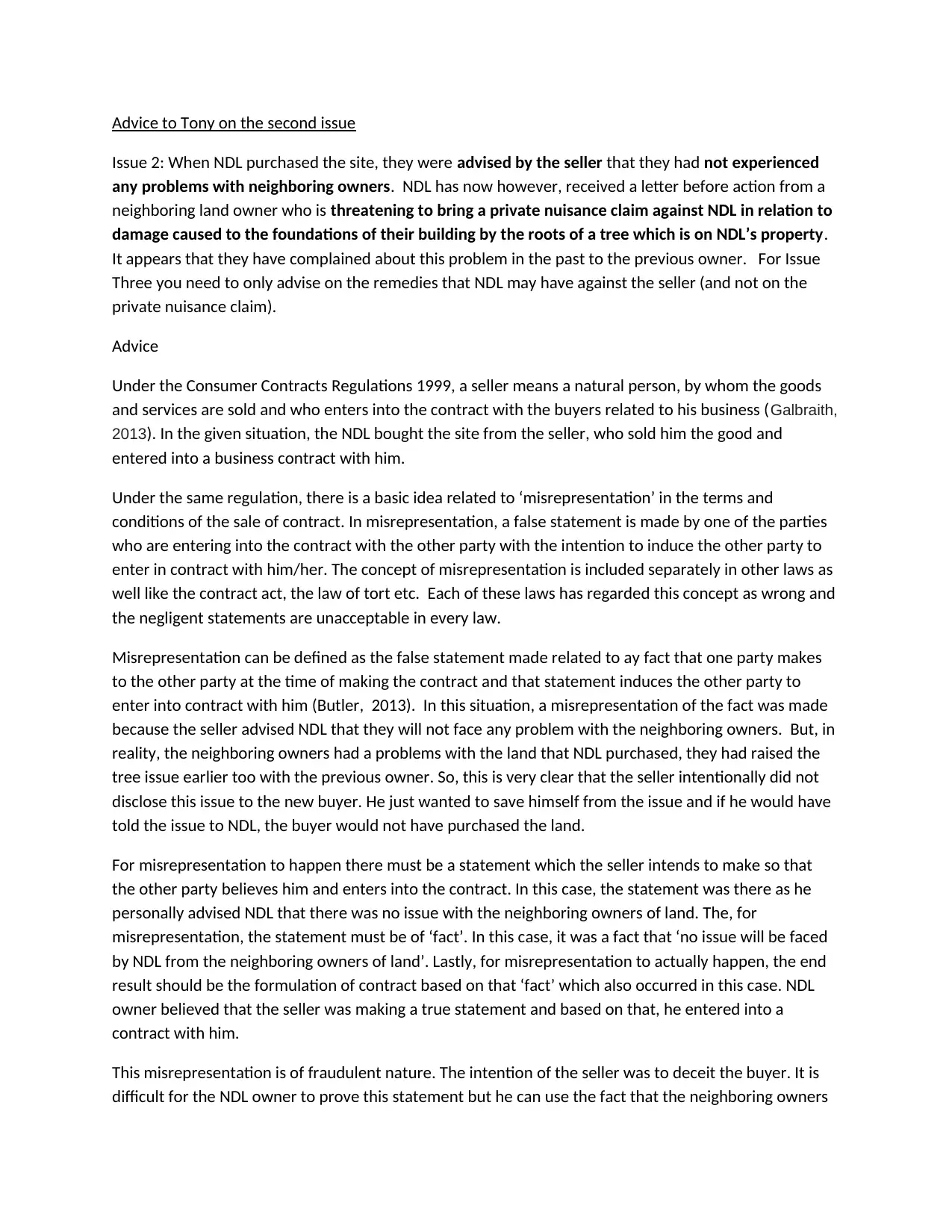
Advice to Tony on the second issue
Issue 2: When NDL purchased the site, they were advised by the seller that they had not experienced
any problems with neighboring owners. NDL has now however, received a letter before action from a
neighboring land owner who is threatening to bring a private nuisance claim against NDL in relation to
damage caused to the foundations of their building by the roots of a tree which is on NDL’s property.
It appears that they have complained about this problem in the past to the previous owner. For Issue
Three you need to only advise on the remedies that NDL may have against the seller (and not on the
private nuisance claim).
Advice
Under the Consumer Contracts Regulations 1999, a seller means a natural person, by whom the goods
and services are sold and who enters into the contract with the buyers related to his business (Galbraith,
2013). In the given situation, the NDL bought the site from the seller, who sold him the good and
entered into a business contract with him.
Under the same regulation, there is a basic idea related to ‘misrepresentation’ in the terms and
conditions of the sale of contract. In misrepresentation, a false statement is made by one of the parties
who are entering into the contract with the other party with the intention to induce the other party to
enter in contract with him/her. The concept of misrepresentation is included separately in other laws as
well like the contract act, the law of tort etc. Each of these laws has regarded this concept as wrong and
the negligent statements are unacceptable in every law.
Misrepresentation can be defined as the false statement made related to ay fact that one party makes
to the other party at the time of making the contract and that statement induces the other party to
enter into contract with him (Butler, 2013). In this situation, a misrepresentation of the fact was made
because the seller advised NDL that they will not face any problem with the neighboring owners. But, in
reality, the neighboring owners had a problems with the land that NDL purchased, they had raised the
tree issue earlier too with the previous owner. So, this is very clear that the seller intentionally did not
disclose this issue to the new buyer. He just wanted to save himself from the issue and if he would have
told the issue to NDL, the buyer would not have purchased the land.
For misrepresentation to happen there must be a statement which the seller intends to make so that
the other party believes him and enters into the contract. In this case, the statement was there as he
personally advised NDL that there was no issue with the neighboring owners of land. The, for
misrepresentation, the statement must be of ‘fact’. In this case, it was a fact that ‘no issue will be faced
by NDL from the neighboring owners of land’. Lastly, for misrepresentation to actually happen, the end
result should be the formulation of contract based on that ‘fact’ which also occurred in this case. NDL
owner believed that the seller was making a true statement and based on that, he entered into a
contract with him.
This misrepresentation is of fraudulent nature. The intention of the seller was to deceit the buyer. It is
difficult for the NDL owner to prove this statement but he can use the fact that the neighboring owners
Issue 2: When NDL purchased the site, they were advised by the seller that they had not experienced
any problems with neighboring owners. NDL has now however, received a letter before action from a
neighboring land owner who is threatening to bring a private nuisance claim against NDL in relation to
damage caused to the foundations of their building by the roots of a tree which is on NDL’s property.
It appears that they have complained about this problem in the past to the previous owner. For Issue
Three you need to only advise on the remedies that NDL may have against the seller (and not on the
private nuisance claim).
Advice
Under the Consumer Contracts Regulations 1999, a seller means a natural person, by whom the goods
and services are sold and who enters into the contract with the buyers related to his business (Galbraith,
2013). In the given situation, the NDL bought the site from the seller, who sold him the good and
entered into a business contract with him.
Under the same regulation, there is a basic idea related to ‘misrepresentation’ in the terms and
conditions of the sale of contract. In misrepresentation, a false statement is made by one of the parties
who are entering into the contract with the other party with the intention to induce the other party to
enter in contract with him/her. The concept of misrepresentation is included separately in other laws as
well like the contract act, the law of tort etc. Each of these laws has regarded this concept as wrong and
the negligent statements are unacceptable in every law.
Misrepresentation can be defined as the false statement made related to ay fact that one party makes
to the other party at the time of making the contract and that statement induces the other party to
enter into contract with him (Butler, 2013). In this situation, a misrepresentation of the fact was made
because the seller advised NDL that they will not face any problem with the neighboring owners. But, in
reality, the neighboring owners had a problems with the land that NDL purchased, they had raised the
tree issue earlier too with the previous owner. So, this is very clear that the seller intentionally did not
disclose this issue to the new buyer. He just wanted to save himself from the issue and if he would have
told the issue to NDL, the buyer would not have purchased the land.
For misrepresentation to happen there must be a statement which the seller intends to make so that
the other party believes him and enters into the contract. In this case, the statement was there as he
personally advised NDL that there was no issue with the neighboring owners of land. The, for
misrepresentation, the statement must be of ‘fact’. In this case, it was a fact that ‘no issue will be faced
by NDL from the neighboring owners of land’. Lastly, for misrepresentation to actually happen, the end
result should be the formulation of contract based on that ‘fact’ which also occurred in this case. NDL
owner believed that the seller was making a true statement and based on that, he entered into a
contract with him.
This misrepresentation is of fraudulent nature. The intention of the seller was to deceit the buyer. It is
difficult for the NDL owner to prove this statement but he can use the fact that the neighboring owners
⊘ This is a preview!⊘
Do you want full access?
Subscribe today to unlock all pages.

Trusted by 1+ million students worldwide
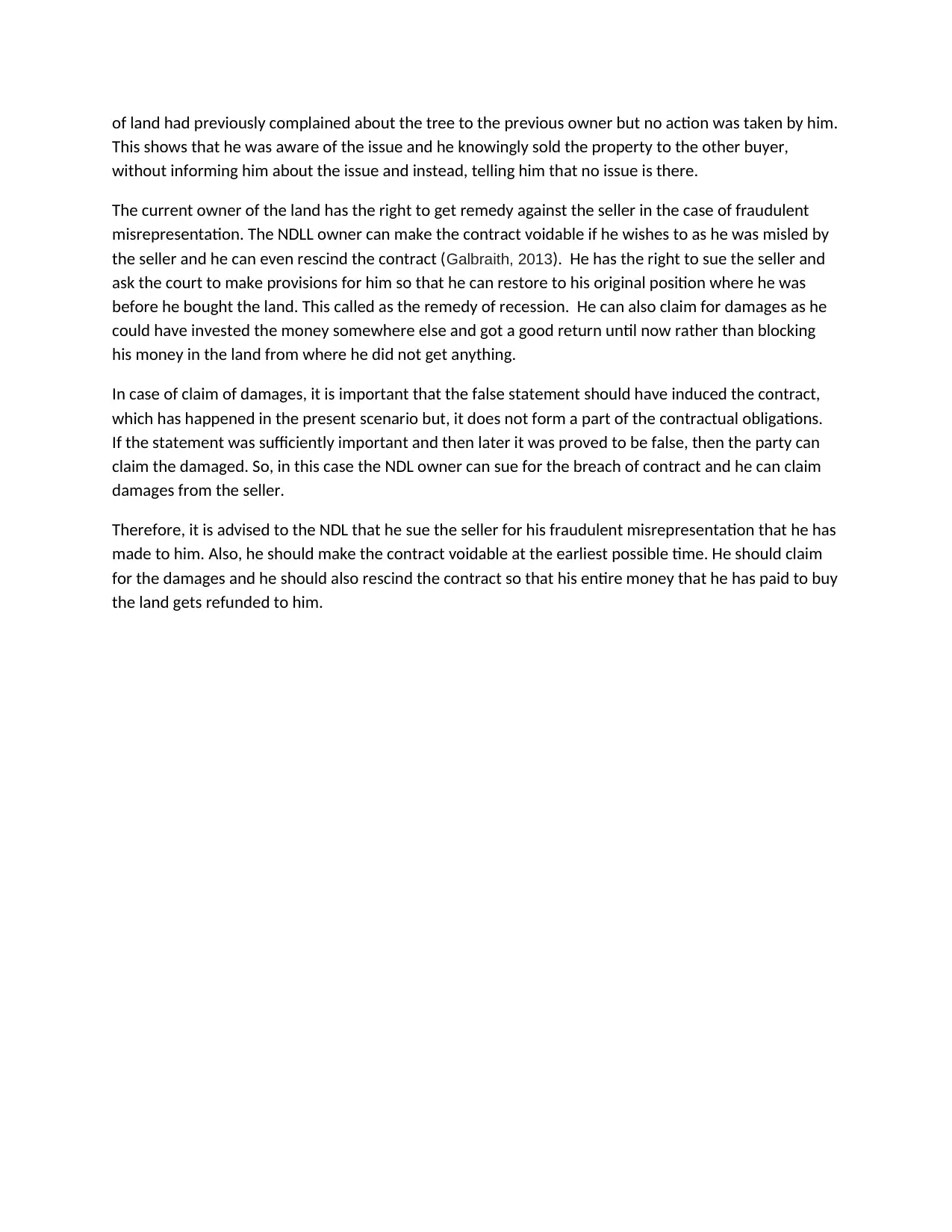
of land had previously complained about the tree to the previous owner but no action was taken by him.
This shows that he was aware of the issue and he knowingly sold the property to the other buyer,
without informing him about the issue and instead, telling him that no issue is there.
The current owner of the land has the right to get remedy against the seller in the case of fraudulent
misrepresentation. The NDLL owner can make the contract voidable if he wishes to as he was misled by
the seller and he can even rescind the contract (Galbraith, 2013). He has the right to sue the seller and
ask the court to make provisions for him so that he can restore to his original position where he was
before he bought the land. This called as the remedy of recession. He can also claim for damages as he
could have invested the money somewhere else and got a good return until now rather than blocking
his money in the land from where he did not get anything.
In case of claim of damages, it is important that the false statement should have induced the contract,
which has happened in the present scenario but, it does not form a part of the contractual obligations.
If the statement was sufficiently important and then later it was proved to be false, then the party can
claim the damaged. So, in this case the NDL owner can sue for the breach of contract and he can claim
damages from the seller.
Therefore, it is advised to the NDL that he sue the seller for his fraudulent misrepresentation that he has
made to him. Also, he should make the contract voidable at the earliest possible time. He should claim
for the damages and he should also rescind the contract so that his entire money that he has paid to buy
the land gets refunded to him.
This shows that he was aware of the issue and he knowingly sold the property to the other buyer,
without informing him about the issue and instead, telling him that no issue is there.
The current owner of the land has the right to get remedy against the seller in the case of fraudulent
misrepresentation. The NDLL owner can make the contract voidable if he wishes to as he was misled by
the seller and he can even rescind the contract (Galbraith, 2013). He has the right to sue the seller and
ask the court to make provisions for him so that he can restore to his original position where he was
before he bought the land. This called as the remedy of recession. He can also claim for damages as he
could have invested the money somewhere else and got a good return until now rather than blocking
his money in the land from where he did not get anything.
In case of claim of damages, it is important that the false statement should have induced the contract,
which has happened in the present scenario but, it does not form a part of the contractual obligations.
If the statement was sufficiently important and then later it was proved to be false, then the party can
claim the damaged. So, in this case the NDL owner can sue for the breach of contract and he can claim
damages from the seller.
Therefore, it is advised to the NDL that he sue the seller for his fraudulent misrepresentation that he has
made to him. Also, he should make the contract voidable at the earliest possible time. He should claim
for the damages and he should also rescind the contract so that his entire money that he has paid to buy
the land gets refunded to him.
Paraphrase This Document
Need a fresh take? Get an instant paraphrase of this document with our AI Paraphraser
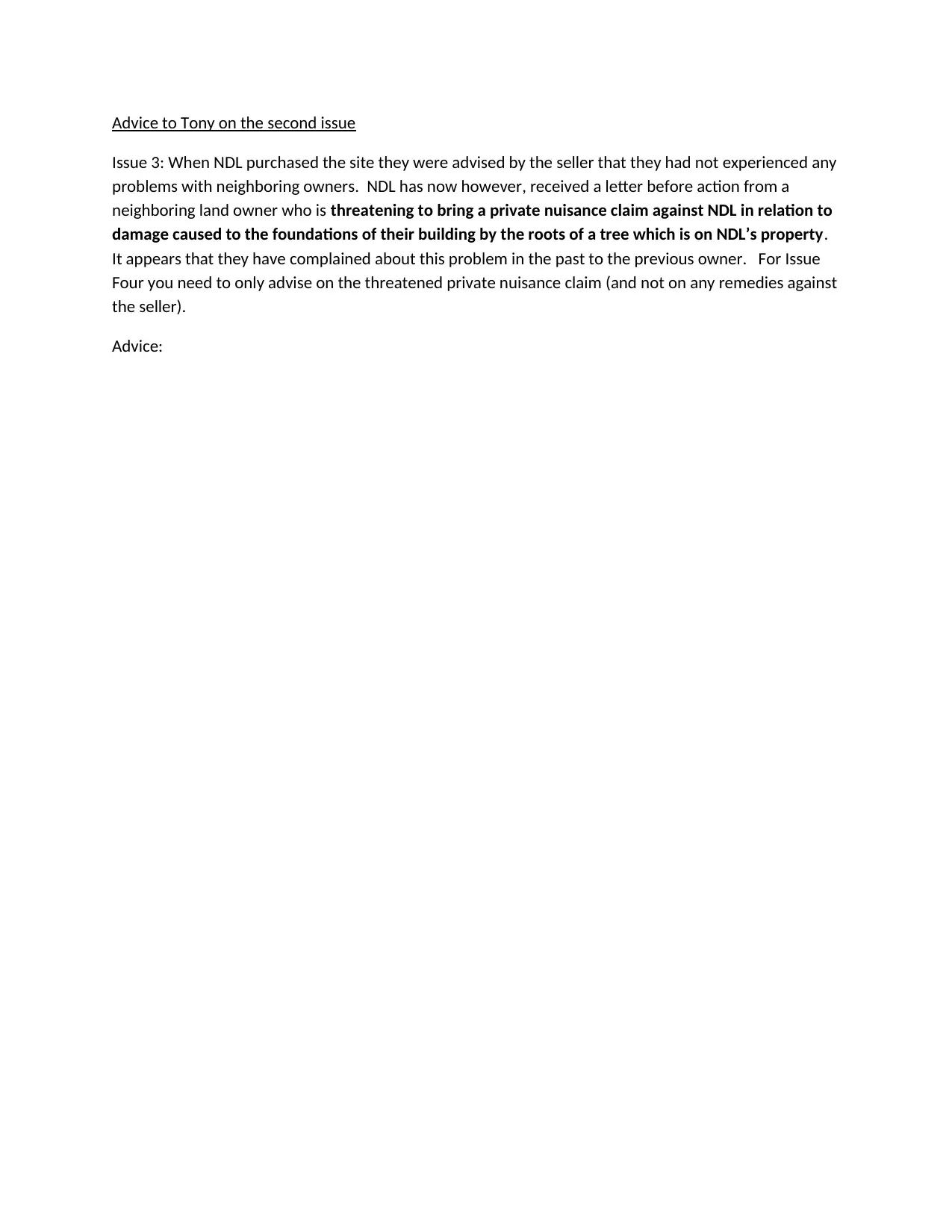
Advice to Tony on the second issue
Issue 3: When NDL purchased the site they were advised by the seller that they had not experienced any
problems with neighboring owners. NDL has now however, received a letter before action from a
neighboring land owner who is threatening to bring a private nuisance claim against NDL in relation to
damage caused to the foundations of their building by the roots of a tree which is on NDL’s property.
It appears that they have complained about this problem in the past to the previous owner. For Issue
Four you need to only advise on the threatened private nuisance claim (and not on any remedies against
the seller).
Advice:
Issue 3: When NDL purchased the site they were advised by the seller that they had not experienced any
problems with neighboring owners. NDL has now however, received a letter before action from a
neighboring land owner who is threatening to bring a private nuisance claim against NDL in relation to
damage caused to the foundations of their building by the roots of a tree which is on NDL’s property.
It appears that they have complained about this problem in the past to the previous owner. For Issue
Four you need to only advise on the threatened private nuisance claim (and not on any remedies against
the seller).
Advice:
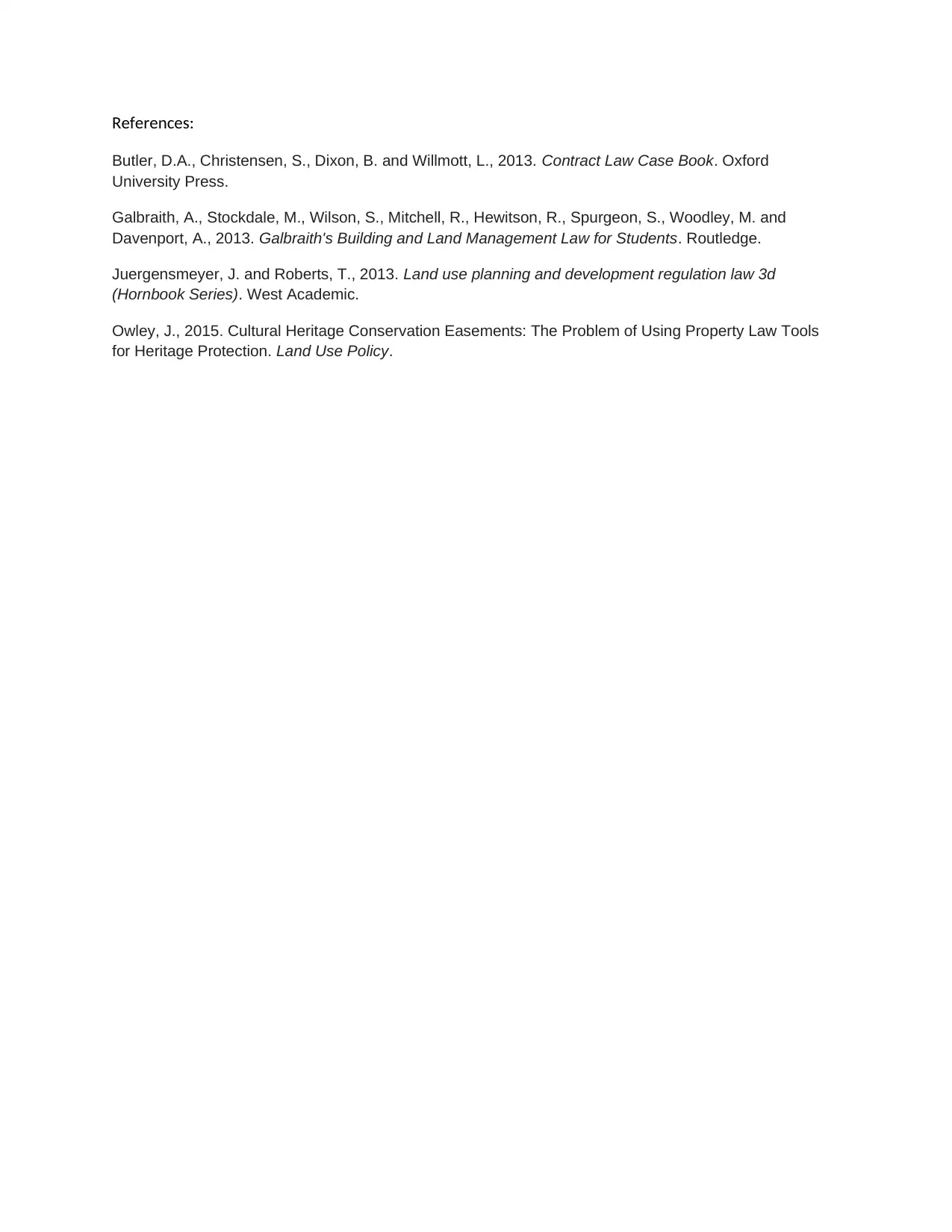
References:
Butler, D.A., Christensen, S., Dixon, B. and Willmott, L., 2013. Contract Law Case Book. Oxford
University Press.
Galbraith, A., Stockdale, M., Wilson, S., Mitchell, R., Hewitson, R., Spurgeon, S., Woodley, M. and
Davenport, A., 2013. Galbraith's Building and Land Management Law for Students. Routledge.
Juergensmeyer, J. and Roberts, T., 2013. Land use planning and development regulation law 3d
(Hornbook Series). West Academic.
Owley, J., 2015. Cultural Heritage Conservation Easements: The Problem of Using Property Law Tools
for Heritage Protection. Land Use Policy.
Butler, D.A., Christensen, S., Dixon, B. and Willmott, L., 2013. Contract Law Case Book. Oxford
University Press.
Galbraith, A., Stockdale, M., Wilson, S., Mitchell, R., Hewitson, R., Spurgeon, S., Woodley, M. and
Davenport, A., 2013. Galbraith's Building and Land Management Law for Students. Routledge.
Juergensmeyer, J. and Roberts, T., 2013. Land use planning and development regulation law 3d
(Hornbook Series). West Academic.
Owley, J., 2015. Cultural Heritage Conservation Easements: The Problem of Using Property Law Tools
for Heritage Protection. Land Use Policy.
⊘ This is a preview!⊘
Do you want full access?
Subscribe today to unlock all pages.

Trusted by 1+ million students worldwide
1 out of 6
Your All-in-One AI-Powered Toolkit for Academic Success.
+13062052269
info@desklib.com
Available 24*7 on WhatsApp / Email
![[object Object]](/_next/static/media/star-bottom.7253800d.svg)
Unlock your academic potential
Copyright © 2020–2025 A2Z Services. All Rights Reserved. Developed and managed by ZUCOL.


